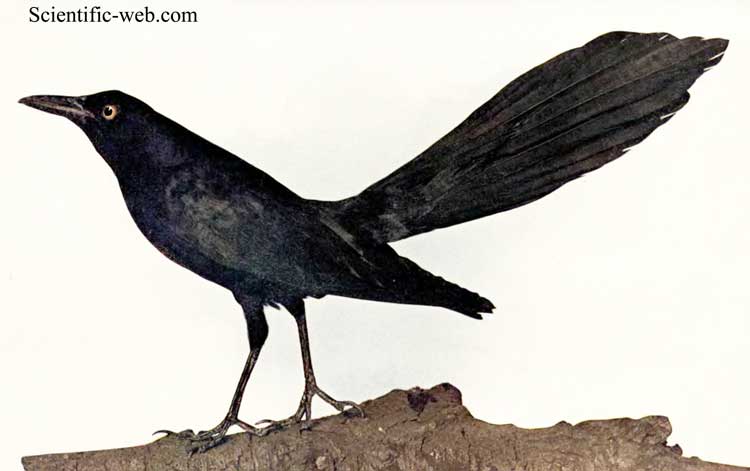
Quiscalus major
Superregnum: Eukaryota
Cladus: Unikonta
Cladus: Opisthokonta
Cladus: Holozoa
Regnum: Animalia
Subregnum: Eumetazoa
Cladus: Bilateria
Cladus: Nephrozoa
Superphylum: Deuterostomia
Phylum: Chordata
Subphylum: Vertebrata
Infraphylum: Gnathostomata
Megaclassis: Osteichthyes
Cladus: Sarcopterygii
Cladus: Rhipidistia
Cladus: Tetrapodomorpha
Cladus: Eotetrapodiformes
Cladus: Elpistostegalia
Superclassis: Tetrapoda
Cladus: Reptiliomorpha
Cladus: Amniota
Classis: Reptilia
Cladus: Eureptilia
Cladus: Romeriida
Subclassis: Diapsida
Cladus: Sauria
Infraclassis: Archosauromorpha
Cladus: Crurotarsi
Divisio: Archosauria
Cladus: Avemetatarsalia
Cladus: Ornithodira
Subtaxon: Dinosauromorpha
Cladus: Dinosauriformes
Cladus: Dracohors
Cladus: Dinosauria
Ordo: Saurischia
Cladus: Eusaurischia
Subordo: Theropoda
Cladus: Neotheropoda
Cladus: Averostra
Cladus: Tetanurae
Cladus: Avetheropoda
Cladus: Coelurosauria
Cladus: Tyrannoraptora
Cladus: Maniraptoromorpha
Cladus: Maniraptoriformes
Cladus: Maniraptora
Cladus: Pennaraptora
Cladus: Paraves
Cladus: Eumaniraptora
Cladus: Avialae
Infraclassis: Aves
Cladus: Euavialae
Cladus: Avebrevicauda
Cladus: Pygostylia
Cladus: Ornithothoraces
Cladus: Ornithuromorpha
Cladus: Carinatae
Parvclassis: Neornithes
Cohors: Neognathae
Cladus: Neoaves
Cladus: Telluraves
Cladus: Australaves
Ordo: Passeriformes
Subordo: Passeri
Infraordo: Passerida
Superfamilia: Passeroidea
Familia: Icteridae
Genus: Quiscalus
Species: Quiscalus major
Subspecies: Q. m. alabamensis – Q. m. major – Q. m. torreyi – Q. m. westoni
Name
Quiscalus major Vieillot, 1819
Type locality: New Orleans, Louisiana, USA.
Synonymy
Quiscalus macrourus Swainson, 1838 Anim. Menag. p. 299 BHL
References
Vieillot, L.J.P. 1819. Nouveau Dictionnaire d’Histoire naturelle, appliquée aux arts, à l'agriculture, à l'économie rurale et domestique, à la médecine, etc. Par une société de naturalistes et d'agriculteurs. Avec des figures tirées des trois règnes de la nature. Tome 28. 570 pp. +11 tt. Déterville, Paris. p. 487 BHL Reference page.
Vernacular names
čeština: Vlhovec člunoocasý
Cymraeg: Gregl fawr
dansk: Bådhalet Grackel
Deutsch: Bootschwanzgrackel
English: Boat-tailed Grackle
Esperanto: Marmarĉa kviskalo
español: Quiscale de pantano
suomi: Mölyturpiaali
français: Quiscale des marais
magyar: Nagy csónakfarkú
italiano: Gracchio maggiore americano
日本語: キタオナガクロムクドリモドキ
Nederlands: Bootstaarttroepiaal
norsk: Båthaletrupial
Diné bizaad: Haʼaʼaahdę́ę́ʼ chʼagiitseenézí
polski: Wilgowron żaglosterny
português: Iraúna-dos-paúis
русский: Лодкохвостый гракл
slovenčina: Vlhovec pobrežný
svenska: Större båtstjärt
中文: 宽尾拟八哥
The boat-tailed grackle (Quiscalus major) is a passerine bird of the family Icteridae found as a permanent resident on the coasts of the Southeastern United States.
Habitat
The boat-tailed grackle is found in coastal saltwater marshes and, in Florida, also on inland waters. Boat-tailed grackles have established significant populations in several United States Gulf Coast cities and towns, where they can be found foraging in trash bins, dumpsters, and parking lots.
Breeding
The nest is a well-concealed cup in trees or shrubs near water; three to five eggs are laid.
Description
The male boat-tailed grackle is 37–43 cm (15–17 in) long and weighs 165–250 g (5.8–8.8 oz).[2] Adult males have entirely iridescent black plumage, a long dark bill, a pale yellowish or brown iris, and a long keel-shaped tail. The adult female is much smaller at 26–33 cm (10–13 in) long and a weight of 90–115 g (3.2–4.1 oz).[3] She is also distinguished by her shorter tail and tawny-brown coloration, which covers the body apart from the darker wings and tail. The wingspan in adult birds is 39–50 cm (15–20 in).[4] In standard measurements, this species measures 13–20 cm (5.1–7.9 in) along the wing bone, 11–20 cm (4.3–7.9 in) in tail length, 2–4.2 cm (0.79–1.65 in) along the culmen, and 3.6–5.8 cm (1.4–2.3 in) along the tarsus.[5] On average, the boat-tailed grackle weighs about 10% more than the closely related great-tailed grackle, although the male great-tailed grackle has an even longer tail.[5][6]
Young males are black but lack the adult's iridescence. Immature females are duller versions of the adult female and have blotches or spots on the breast. The eye color of the boat-tailed grackle varies with range. Gulf Coast and inland birds have dark eyes, whereas Atlantic birds have pale eyes.[7]
Taxonomy
The boat-tailed grackle was first described by French naturalist Louis Jean Pierre Vieillot in 1819. Its specific epithet major means "larger" in Latin. Despite its restricted range, there are four subspecies of the boat-tailed grackle, differing in size and iris color. The boat-tailed grackle was once considered the same species as the great-tailed grackle. The great-tailed species is generally quite similar of slightly smaller body size but has a longer tail and lacks this species' distinct domed head shape. The common grackle, with which the boat-tailed species often overlaps along the Atlantic coastline, is noticeably smaller and shorter-tailed, as well as lacking the domed head shape.
Diet
They forage on the ground, in shallow water, or in shrubs; they will steal food from other birds. They are omnivorous, eating insects, minnows, frogs, eggs, berries, seeds, grain, and even small birds.
Call
Its song is a harsh jeeb, and it has a variety of typically grackle-like chatters and squeaks.
References
BirdLife International (2016). "Quiscalus major". IUCN Red List of Threatened Species. 2016: e.T22724311A94859792. doi:10.2305/IUCN.UK.2016-3.RLTS.T22724311A94859792.en. Retrieved 12 November 2021.
"FieldGuides: Species Detail". eNature. Archived from the original on 23 June 2013. Retrieved 5 March 2013.
Bancroft, G.T. (1984). "Growth and sexual dimorphism of the Boat-tailed Grackle" (PDF). Condor. 86 (4): 423–432. doi:10.2307/1366822. JSTOR 1366822.
"Boat-tailed Grackle". All About Birds. Cornell Lab of Ornithology. Retrieved 5 March 2013. "Boat-tailed Grackle, Life History, All About Birds – Cornell Lab of Ornithology". Allaboutbirds.org. Retrieved 2013-03-05.
Jaramillo, Alvaro; Burke, Peter (1999). New World Blackbirds: The Icterids. Christopher Helm Publishing. ISBN 978-0713643336.
Dunning Jr., John B., ed. (1992). CRC Handbook of Avian Body Masses. CRC Press. ISBN 978-0849342585.
"Grackles – Are you getting them right?". eBird.org.
Retrieved from "http://en.wikipedia.org/"
All text is available under the terms of the GNU Free Documentation License

